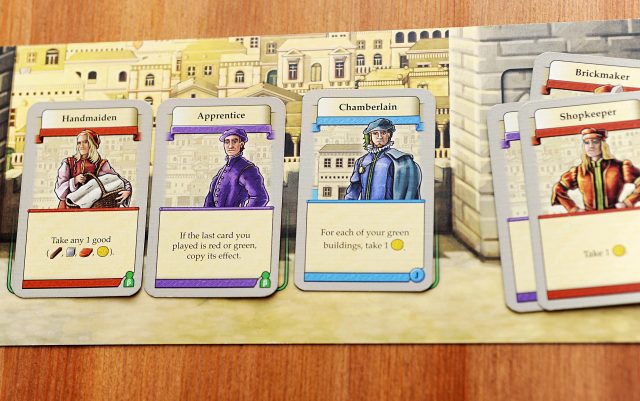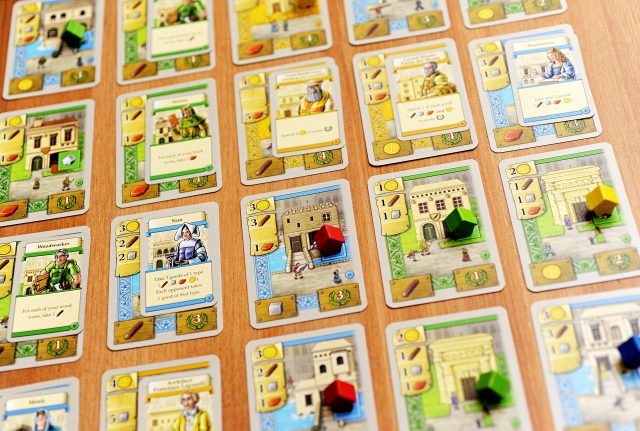When you first unbox Valletta, you’ll find the usual suspects: wood, cardboard, rules, and a card reference booklet. But one thing I never expected to find was a tourism advertisement extolling the virtues of the city my new board game was asking me to build. “That’s an awfully nice city you’ve built there. Why not come visit it?”. Not once had I considered visiting Valletta (as I’d never heard of it). Nor had I contemplated a journey to Malta (where I now know Valletta is). And although I have no immediate plans to vacation there, it’s now on that list of places I’d like to go. Very clever, ghost of Jean Parisot.
Who is that? Why, Jean Parisot de Valette is the French nobleman who saw the picturesque slopes of Mount Sciberras and thought, “I should build a city”. And that’s what the players of Stefan Dorra’s latest title, Valletta, are attempting to do.
 Briefly, Valletta is a deck-building game with a euro twist, where cards are played to collect resources and construct buildings. Those buildings give the player new cards to add to their deck, thereby granting you easier access to resources, the ability to interfere with your opponents, and ultimately the capacity to generate victory points.
Briefly, Valletta is a deck-building game with a euro twist, where cards are played to collect resources and construct buildings. Those buildings give the player new cards to add to their deck, thereby granting you easier access to resources, the ability to interfere with your opponents, and ultimately the capacity to generate victory points.
The blueprint for Valletta (i.e. the setup for the game) is randomly created according to rules that vary by the number of players. More players: more buildings to choose from. Regardless, the table is lined with 4 columns featuring a proportionate number of green, blue, and yellow buildings. Each building is then supplied with its character card – building and character cards are paired by small letters printed on each them. Each player receives one of each good (wood, brick, stone, and gold), and an 8 card starting deck, from which they immediately draw 5 cards.
Among these starting cards are labourers who will each acquire you one of a particular good, an Apprentice who can copy a previously played card, a Builder who allows you to spend those goods to construct new buildings, and Jean Parisot de Valette himself. Yes, each player has their own Jean Parisot card, which they can use to hire extra builders or fire characters from hand, thereby slimming your deck for greater efficiency. Playing the Jean Parisot card also moves the  purple Jean Parisot figure forward one space along the score track, revealing a face down barrel token which awards the player the good depicted on it. His position on this 25 space track of his is also relevant when constructing buildings, but more on that later.
purple Jean Parisot figure forward one space along the score track, revealing a face down barrel token which awards the player the good depicted on it. His position on this 25 space track of his is also relevant when constructing buildings, but more on that later.
There are only two explanations for each player having their own Jean Parisot card. One is that, ol’ J.P. was a busy man, delegating work to a number of otherwise independent labourers responsible for creating what will one day be a delightful tourist destination that you should absolutely visit at your earliest convenience. Or, this game takes place in an alternate universe where there are two, three, or even four Jean Parisot clones, pitted against each other in a savage city building competition. I choose to believe the latter.
On your turn, you will play three cards, one after the other, each of them resolving before the next is played.This is irrelevant most of the time, as many of your cards will simply collect you varying types of goods. However, it becomes very important when you play a Builder card, and pay the according goods to a) place one of your wooden buildings on the building card, which is worth points at the end of the game, and b) place the character card on that building directly into your hand. Unlike most other deck-building games, you are able to use a card on the very turn you acquire it, which is often incredibly satisfying.
Once you’ve played and resolved three cards, you discard them, refresh your hand to five, and the following player begins their turn. As you  build, you’ll acquire a variety of characters. Green characters have the capacity to acquire goods more efficiently than those in your starting deck; they each collect goods of a specific type, but the number you receive depends on how many of that good type are featured on your constructed buildings. The more you’ve invested in brick buildings, for instance, the more efficient your Mason becomes. Blue characters are the most interesting and varied, allowing you flexibility in the goods you acquire, or the ability to steal them from others. Finally, yellow characters are of a more noble persuasion, and can score victory points each time they are played.
build, you’ll acquire a variety of characters. Green characters have the capacity to acquire goods more efficiently than those in your starting deck; they each collect goods of a specific type, but the number you receive depends on how many of that good type are featured on your constructed buildings. The more you’ve invested in brick buildings, for instance, the more efficient your Mason becomes. Blue characters are the most interesting and varied, allowing you flexibility in the goods you acquire, or the ability to steal them from others. Finally, yellow characters are of a more noble persuasion, and can score victory points each time they are played.
The buildings, their characters, and the way they are randomly dealt is what this game is all about. There’s a lot of information to take in on your first play, but which cards are available, and where they are positioned plays an important role in the strategy of this surprisingly accessible game. You are granted discounts when constructing buildings which are orthogonally adjacent to those you already own, incentivizing a game plan, if you will. You also receive 2 bonus points if you construct a building in the neighbourhood (column of buildings) Jean Parisot currently occupies. This incentivizes players to compete over the same buildings throughout the game, as those 2 bonus points are not to be scoffed at.
It should be known that, in reality, Jean Parisot de Valette never lived long enough to see the completion of Valletta. And this is represented in the game (according to me) by one of the game end triggers. If the players aren’t efficient in their building, and Jean Parisot is played 25 times – moving his figure along a track of facedown barrels, whose contents are awarded to the player who moved him forward – he is worked to death, and the game end phase is triggered: each player shuffles their discard and draw piles together. The game finally ends after all players have played through their deck and hand for the final time. The game end can also be triggered by a player either building their 8th building or reaching 25 points on the score track. And, when all is said and done, whoever has the most victory points is declared the winner (of an all expenses paid trip to Malta).
The fact that each player gets one final run through their deck is a big plus, and significantly adds to my enjoyment of the game. It always feels bad to purchase a card late in a deck building game, wondering if you’ll ever have the opportunity to actually play it. Valletta handles this effortlessly with this final reshuffle, and the fact that new cards are immediately added to a player’s hand.
What I like most about Valletta is that it feels immediately familiar. It’s a deck building game firmly planted in a euro gaming aesthetic. You use brick, stone, wood, and coins to construct a European town in the late renaissance. It’s comfortable, and immediately relaxing; like an old pair of slippers. Those of you who enjoy the familiar and uncomplicated will find that Valletta fits you like a glove. However, I would suggest that those looking for a game that boldly goes where no other game has gone before look elsewhere. Valletta takes a number of tried and true mechanisms and meshes them delightfully well, and with little innovation. This statement comes with no negative intention on my part, as I love the game. Just a simple fact.
 As the game is a Z-Man/Hans im Glück production, the art and components are unsurprisingly great. Klemens Franz’s slightly goofy cartoon artwork suits Valletta perfectly. My only complaint (and this is picky and minor) is that the wooden houses used to represent the player’s buildings have angled tops, when the buildings of real life Valletta are largely flat topped. Granted, the original box cover had pointed tops, and sufficient outcry on Board Game Geek prompted the publisher or the artist to correct it. There was clearly some effort to honour the city’s architecture, but it was probably just cheaper for them to use Thurn and Taxis houses, in the end.
As the game is a Z-Man/Hans im Glück production, the art and components are unsurprisingly great. Klemens Franz’s slightly goofy cartoon artwork suits Valletta perfectly. My only complaint (and this is picky and minor) is that the wooden houses used to represent the player’s buildings have angled tops, when the buildings of real life Valletta are largely flat topped. Granted, the original box cover had pointed tops, and sufficient outcry on Board Game Geek prompted the publisher or the artist to correct it. There was clearly some effort to honour the city’s architecture, but it was probably just cheaper for them to use Thurn and Taxis houses, in the end.
Everyone I’ve introduced to Valletta has enjoyed it. It’s an approachable family game with interesting decisions and satisfying gameplay, and I’m glad to have it in my collection. I think it’s going to be a big hit amongst the crowd who enjoys lighter euro fare.For comparison (after the relevant paragraph):
[…] management is a crucial aspect of the Valetta board game strategy. In this game, players must carefully allocate and use their resources in order to construct […]